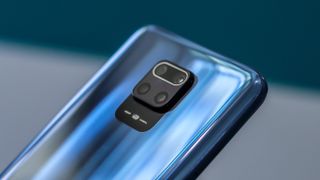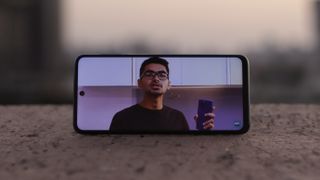TechRadar Verdict
The Redmi Note 9S offers one of the most reliable experiences on a phone at its super-low price point. Its battery life is unmatched, the performance is always consistent, and the large display is a joy to use.
Pros
- +
Impressive battery life
- +
Reliable performance
- +
Big and vibrant display
Cons
- -
'Only' 60Hz display
- -
Relatively slow charging
- -
Bulky build
Why you can trust TechRadar
Xiaomi’s Redmi Note series has so far been a compelling line of affordable phones, including some of the best budget powerhouses we’ve ever seen. Looking at them, it’s easy to understand why they have been so well received - big displays, decent performance, and reliable batteries, ensuring they nail the basic necessities that consumers look for.
With the Redmi Note 9S, Xiaomi seems to be moving up the price ladder to provide a more premium experience, with the slightly cheaper Redmi Note 9 landing for people who still want a very cheap smartphone.
It's worth pointing out that the Xiaomi Redmi Note 9S is basically exactly the same phone as the India-only version of the Redmi Note 9 Pro, which itself is different in a few ways to the Redmi Note 9 Pro sold globally. That's pretty confusing, we're aware, but suffice to say the Note 9S is different to the Note 9 Pro in the regions where both are available.
This review is based on a unit of the Redmi Note 9 Pro in India, but as that's the same phone as the Note 9S, our experiences will match what you can expect from the Redmi Note 9S.
The Redmi Note 9S is best seen as a successor to the Redmi Note 8 Pro from 2019, which made strides in terms of the performance, battery capacity, and display size. Interestingly, those remain the key areas of improvement with the Redmi Note 9S, almost as if Xiaomi has figured out what aspects matter the most.
- These are the best Xiaomi phones
Xiaomi Redmi Note 9S price and availability
The Xiaomi Redmi Note 9S is available to buy only in the UK, at the time of writing, though that might change. It comes in two sizing versions - one with 4GB of RAM and 64GB of storage, and another 6GB / 128GB combo.
In the UK you can pick it up for £199 (roughly $250 / AU$370), so it's a rather cheap phone. That's for the 4GB / 64GB version, but for the 6GB / 128GB model you'll be paying £229 (around $280, AU$420). In any case, that's a price that ensures it ranks among the best cheap phones.
Based on previous Xiaomi phones we wouldn't expect the Xiaomi Redmi Note 9S to make its way to the US, and Australian availability is uncertain because while many Xiaomi Mi phones are released there, not many Redmi phones are.
Saying that, one of the few Redmi phones in Australia is the Redmi Note 8 Pro, so the Note 9S going on sale there wouldn't be totally shocking.
Design

Xiaomi’s smartphone designs have matured by great lengths in recent years, going from uninspiring metal backs to high-end glass sandwiches. The Redmi Note 9S is a refinement to the design of previous phones, and the result is a hefty phone with a unibody glass design that looks better than what the price tag may suggest.
The Xiaomi Redmi Note 9S's camera bump protrudes considerably, but the phone doesn’t rock much while it’s on a table, presumably because of the square 2 x 2 camera layout instead of the lenses being in a straight line across the spine.
Around the bump there's a slight lip to avoid the lenses scratching, and because of this the bump is one of the most pronounced we've seen on a recent smartphone. Aside from the camera island, the back is pretty minimal and classy with no other eyesores. Notably, both the back and the cameras are covered by Gorilla Glass 5, unlike previous Redmi phones.
While the move to a premium finish is appreciated, there is no denying that this is a big and heavy phone. While it does bring a bigger display and battery to justify that stature (more on that ahead), you’ll have a hard time fitting it in your pocket.
Moving your hand to interact with the length of the screen is sure to tire your wrists. Other inherent big phone problems, such as an inability to use it one-handed or difficulty in reaching the volume rocker, are also experienced here.
The back of the Redmi Note 9S is rather slippery, which gets aggravated due to the sheer size of the phone. It will start gliding off any surface you place it on. Thankfully, a silicone case is included in the box.

The power button on the right edge of the phone doubles as a side-mounted fingerprint scanner and is placed in a natural position. Having the power button and scanner combined means there’s a small learning curve associated with it, as there will be instances when the display will get unlocked when you want to lock it and vice versa.
Next to this power button is the volume rocker, though like we said we found it a little hard to reach due to the size of the phone. There's also a 3.5mm headphone jack on the phone, perfect for people who like their audio wired.
Display

Big displays have been a part of the Redmi Note series’ DNA from the beginning, with each generation overshadowing the last. The Redmi Note 9S is no different. Thanks to its 6.67-inch display, it’s the biggest screen ever seen on the series, and it has a tall 20:9 aspect ratio. Viewing videos or playing games on this bigger canvas is enjoyable and immersive.
It’s an LCD panel with a resolution of 2,400 x 1,080. The max brightness is just about adequate, but stronger outdoor sunlight can definitely overpower it. Because it's LCD, the blacks and contrast levels are far from perfect, and you’ll probably mistake the blacks for greys. The colors otherwise are pretty accurate, at least when viewed head-on.
We did notice occasional light bleeding and non-uniformity across the display, especially when viewing darker content, however this is not very prominent and is easy to overlook. This was predominantly towards the sides and the notch. However, this seems to be an isolated issue and not one that anyone else reported, so it could be a defect with our early model.

The Redmi Note 9S is the first in the family to move to a punch-hole camera, a feature that had previously been reserved for more expensive devices.
Without getting into the debate of which kind of a camera housing is better, we would just like to mention that it is not the smallest we have seen, and seems to be placed just a little lower than on most other devices - therefore it looks unwieldy and stretches the status bar too. But it’s easy to overlook, especially if you’re not comparing it to a high-end device.
Just like the back, the display is also covered by Gorilla Glass 5. In the month that we used the phone without a case, there was not a single scratch or ding across the front or the back, even after multiple drops and slides.
While the display isn’t terrible in any aspect, it falls behind the competition in one key way: refresh rate, as the Redmi Note 9S has the 'standard' 60Hz instead of an increased spec.
We understand that it is unreasonable to expect too much at this price, but we’re talking about a hugely competitive segment of smartphones (super-cheap phones), where one spec can tilt the outcome the other way.
Some of the Redmi Note 9S’ direct competitors - such as the Realme 6 and the Poco X2 - offer higher refresh rates at almost the same price. It’s not a necessity but it makes for a noticeably smoother-seeming interface.
Current page: Price, design, display and performance
Next Page Performance, gaming, software and audioAakash is the engine that keeps TechRadar India running, using his experience and ideas to help consumers get to the right products via reviews, buying guides and explainers. Apart from phones, computers and cameras, he is obsessed with electric vehicles.


